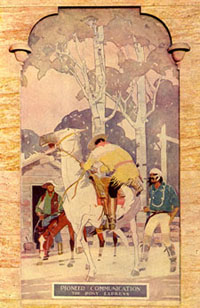Telecommunications History Group Resources
931 14th St. Historic Building
The Pony Express - Local Communications History
Pioneer Communications
The earliest communication to and from pioneers was by word of mouth and letters. When settlers gathered they told each other about people they’d met and heard about, relayed messages from back home and helped spread any other news. One such gathering place was near the site where the telephone building would be constructed. According to Baptiste Pourier, a Frenchman married to a Lakota Sioux, he helped build the first log hut in Denver near the site. It was probably the first of several log houses that formed a little village on the banks of Cherry Creek in 1858. Prairie schooners would put up nearby, and settlers who had come to the new country could collect messages from “back home.”
The development of a central overland mail service between California and the rest of the nation began soon after the California gold rush in 1849. Instead of one transcontinental line, the U.S. Post Office Department broke the overland route into two distinct segments: New York to Salt Lake City and Salt Lake City to San Francisco. Harsh weather conditions, long distances over difficult and treacherous terrain, and problems with Indians along the route thwarted the effort to provide regular mail service.
By the end of 1858, mail was being sent from the East to the West by six different routes—four overland and two ocean mail and passenger routes. The ocean route, via the Isthmus of Panama, was the first choice for mail service between the East and West coasts of the United States. Service between New York City and San Francisco took three to four weeks, and postage ranged from 6¢ to 10¢ a letter.
The Pony Express
Sidebar: Buffalo Bill
In the spring of 1859, Buffalo Bill made his first trip to Colorado as part of the Pikes Peak Gold Rush. He passed through the new town of Denver on his way to the gold fields near Black Hawk, where he searched for gold for two months with little success. On his return to Kansas he stopped in Julesburg, Colorado, where he was recruited to ride in the Pony Express.
By the spring of 1859, routes, frequency, speed, and cost of mail service to California were still in question. This situation, along with other developments like the Pike’s Peak gold rush, set the stage for the birth of the Pony Express.
In the summer of 1858, gold was discovered near the mouth of Cherry Creek and the South Platte River. The Pike’s Peak gold and a major silver deposit in the Washoe hills of Utah Territory (now Nevada) caused yet another rush. As soon as these spectacular discoveries became known, prospectors, speculators, and other hopefuls rushed to these areas to make their fortunes. They immediately demanded some means of communication with their families back home.
In early 1859, the firm of Russell, Majors, and Waddell started the Leavenworth & Pike’s Peak Express Company (L. & P.P. Express Co.), which a year later became the Central Overland California & Pike’s Peak Express Company. This stage and express line was to run between Leavenworth, Kansas and Denver. The new firm hoped to transport mail and miners to the gold fields along a middle route between the Oregon and Santa Fe Trails.
Sidebar: Rocky Mountain News
The Denver Rocky Mountain News imitated the Pony Express on a small scale in 1861. At that time, the News owned and published a paper called the Miner’s Record at Tarryall, a mining community some distance out of Denver. They also had a branch office at Central City, forty-five miles up in the mountains. Information from the Civil War arrived in Denver over the Pony Express and by stage out of Julesburg, and was hurried to these outlying points by fast horsemen. Thanks to this enterprise, the miners in the heart of the Rockies could get their war news only four days late.
First, the L.&P.P. Express Co. surveyed and laid out a new road from Leavenworth to the Rocky Mountain gold diggings. They located twenty-seven stations along the 680-mile route, approximately twenty-five miles apart. One of these stations was located near what would become 14th Street and Curtis, where the phone building now stands. Near the station was a corral for cows and for the fresh horses and mules needed by drivers in order to continue on their routes.
They also ordered fifty new Concord coaches (at $250 each) and bought 800 mules to pull them. To run the operation and attend the needs of the travelers, they employed 108 men as drivers, stock tenders, harness makers, blacksmiths, messengers, and division agents. By May 1859, the L. & P.P. Express Co. scheduled its first trip. They charged $1.25 for a passenger ticket, $1.00 a pound for express packages, and 25¢ for each letter carried. The trip from Leavenworth, Kansas, to Denver took about a week.
The L.&P.P. Express Co. became the Central Overland California and Pike’s Peak Express Co., which would go on to establish an overland express route known as The Pony Express. This service followed the more northerly route through Kansas, Nebraska and Utah, bypassing Denver. The only Pony Express station in Colorado was in Julesburg (see first sidebar). The Central Overland California and Pike’s Peak Express Co. continued to offer passenger and freighting service to and from Denver and California (see second sidebar).
More information about Native American sign language can be found at: https://www.nps.gov/poex/hrs/hrs2d.htm
Also see Allen Tupper True Murals: Curtis Street Outer Lobby

